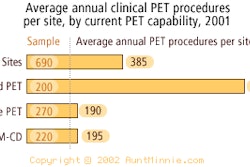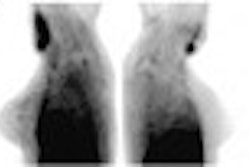Myocardial perfusion imaging should play a bigger role in evaluating women with known or suspected heart disease, according to Dr. Jennifer Mieres, the director of nuclear cardiology at the North Shore University Hospital in Manhasset, NY. Mieres believes that the burden of heart disease falls disproportionately on women.
In a presentation at the 2002 American Society of Nuclear Cardiology meeting in Baltimore last week, Mieres discussed new information that is being uncovered about women and heart disease.
Women may present with symptoms that are different from those experienced by men, and these differences should be taken into account in both the diagnosis and treatment of heart disease, she said. In addition, women die of heart disease in the U.S. more frequently than men, and women are far more likely to die after their first myocardial infarction.
According to the American Heart Association, the average annual rates of first major cardiovascular events rise from 7 per 1,000 women at ages 45-54, to 68 per 1,000 at age 95.94. The gap closes with advancing age. The AHA estimates that 7.5 million Americans, age 20 and older, have a history of myocardial infarction, nearly 3 million of whom are women.
"Women are vulnerable. Women can present with fewer classical symptoms," Mieres said. Arterial plaque may deposit differently in women than in men, obscuring the risk of atherosclerosis, she explained.
Traditional diagnostic tests are often less accurate in women. The exercise treadmill test, for example, is less fruitful in women than in men; also, breast attenuation and small left ventricular chamber size adversely affect thallium-based myocardial perfusion studies. But the introduction of technetium compounds has improved specificity of perfusion imaging, she said.
Mieres cited previous studies that showed the advantages of myocardial perfusion imaging, specifically in women. Dr. Rory Hachamovitch and colleagues from Cedars-Sinai Medical Center and UCLA, both in Los Angeles, found that perfusion SPECT was better at identifying women at high risk than men. The study utilized 1,006 consecutive patients (511 men, 495 women) who underwent SPECT exams.
They determined that "myocardial perfusion SPECT had a significant impact on patient management...women with severely abnormal scan results are at increased risk for hard cardiac events than are men with severely abnormal scan results"(Journal of the American College of Cardiology, Vol. 28:3, pp.680-686).
In a 1997 edition of Current Opinions in Cardiology, Dr. Mark Travin and colleagues stated, "stress myocardial perfusion imaging is highly accurate for diagnosing coronary disease in women, particularly with newer techniques such as gated single-photon emission computed tomography, and has been shown to be a powerful prognostic predictor in both women and men," (Current Opinions in Cardiology, November, 1997, Vol. 12:6, pp. 587-594).
More recently, a London-based group looked at whether a gender bias existed in the management and outcome of patients with acute coronary artery disease. They found that that there was no difference between men and women in the use of cardiac investigations.
"However, male patients with hypertension were more likely to undergo rehabilitation compared with female hypertensive patients. Men were also more likely to undergo coronary artery bypass grafting than women," they reported (Journal of Epidemiology and Community Health, October 2002, Vol. 56:10, pp.791-797).
The ASNC released a consensus statement on women and heart disease at the group's meeting. Authored by a task force led by Mieres, the statement encouraged women with risk factors for heart disease to get a gated SPECT myocardial perfusion scan rather than a simple treadmill test in an effort to ensure that more women were tested -- and tested rigorously.
"If a woman presents with chest pain, it’s much more likely that she won’t get a test done," said Dr. Gary Heller, the associate director of cardiology at Hartford Hospital in Connecticut and the past president of ASNC. "We don’t want women dying of heart disease if they don’t have to."
The ASNC’s effort comes as the National Heart, Lung, and Blood Institute of Bethesda, MD, kicks off a heart-health awareness campaign for women. According to NHLBI director Dr. Claude Lenfant, "less than one-third of American women recognize that heart disease is the leading cause of death among women...this reality is not acceptable."
By Brian ReidAuntMinnie.com contributing writer
October 3, 2002
Additional reporting by Monica L. Lewis.
Related Reading
Real-time MR stress imaging detects cardiac wall-motion abnormalities, September 23, 2002
Heart irregularities common in babies of HIV+ women, June 18, 2002
HRT reduces arterial calcification of the breast, April 4, 2002
Copyright © 2002 AuntMinnie.com




















